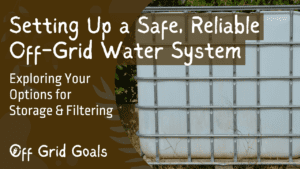Planning a self-sufficient off-grid homestead requires careful consideration of various factors to ensure success and sustainability. Here’s a comprehensive checklist to guide you through the planning process:
- Location and Land Assessment:
- Evaluate potential homestead locations based on factors such as climate, soil quality, water availability, and local zoning regulations.
- Consider proximity to resources such as forests for wood, water sources for irrigation, and access to sunlight for energy generation.
- Water Source and Management:
- Identify and assess available water sources, including wells, springs, rainwater, and surface water.
- Develop a water management plan that includes rainwater harvesting systems, storage tanks, filtration, and conservation measures.
- Ensure water quality testing and treatment to meet health and safety standards.
- Energy Generation:
- Determine the most suitable off-grid energy sources based on location, climate, and energy needs.
- Consider options such as solar panels, wind turbines, hydroelectric generators, and backup generators for reliable power supply.
- Calculate energy requirements and design an appropriate system size to meet household needs.
- Shelter and Infrastructure:
- Design and construct energy-efficient and sustainable living spaces, including homes, outbuildings, and storage facilities.
- Incorporate passive solar design principles, insulation, and natural ventilation for climate control.
- Establish infrastructure for waste management, including composting toilets, greywater recycling systems, and recycling facilities.
- Food Production and Agriculture:
- Plan and develop a diverse and resilient food production system, including vegetable gardens, fruit orchards, and livestock raising.
- Implement permaculture principles, companion planting, and organic gardening practices for sustainable food production.
- Consider greenhouse or hoop house structures for extending the growing season and protecting crops from harsh weather conditions.
- Off-Grid Cooking and Food Preservation:
- Choose appropriate off-grid cooking methods such as outdoor grills, solar ovens, rocket stoves, and cast-iron cookware.
- Develop strategies for food preservation, including canning, drying, fermenting, and root cellaring.
- Ensure adequate food storage facilities, such as root cellars, pantries, and cold storage areas.
- Livelihood and Income Generation:
- Explore opportunities for generating income from the homestead, such as selling surplus produce, handmade crafts, or value-added products.
- Consider alternative livelihood options such as freelance work, remote employment, or running a home-based business.
- Develop a financial plan and budget to support homestead operations and long-term sustainability.
- Community and Support Networks:
- Build connections with like-minded individuals, neighbors, and local communities for mutual support and collaboration.
- Participate in off-grid and sustainable living forums, workshops, and events to exchange knowledge and experiences.
- Establish emergency preparedness plans and networks for community resilience and support during challenging times.
- Regulatory Compliance and Legal Considerations:
- Familiarize yourself with local building codes, zoning regulations, and land-use policies related to off-grid living.
- Obtain necessary permits and approvals for construction, water use, waste management, and other homestead activities.
- Consult with legal experts or land-use professionals to navigate regulatory requirements and ensure compliance.
- Continuous Learning and Adaptation:
- Embrace a mindset of continuous learning and adaptation to evolving circumstances and challenges.
- Stay informed about advances in off-grid technologies, sustainable practices, and resilient living strategies.
- Monitor and evaluate homestead systems and processes regularly, making adjustments as needed to optimize efficiency and productivity.
By following this checklist and taking a systematic approach to planning, you can create a self-sufficient off-grid homestead that aligns with your values, goals, and vision for sustainable living.
Photo by Timothy Eberly on Unsplash



















